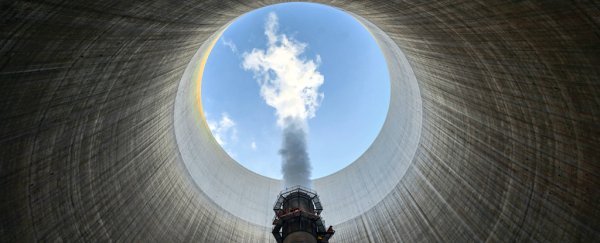Hurricane Florence may affect the operations of several of the 16 nuclear reactors located in the Carolinas and Virginia, raising concerns about safety and power outages.
Ted Kury, director of energy studies at the University of Florida's Public Utility Research Center, explains why nuclear power stations must take precautions during big storms.
1. Keeping cores cool is the top priority.
The top safety concern at nuclear power stations is protecting the nuclear cores of their reactors.
Reactors operate at temperatures exceeding 350 degrees Centigrade, relying on cooling systems to dissipate the heat. When cooling systems malfunction, portions of the reactor core may begin to melt. Meltdowns can lead to explosions and the potential release of radioactive material.
When a reactor's power supply is interrupted, it may affect the system's ability to cool the plant.
To prevent accidents, the outer wall of reactor containment systems are made out of reinforced concrete and steel. Since they are designed to withstand the impact of a large commercial airliner, flying debris – even if it's propelled by 200 mph winds – is unlikely to pose much of a threat.
Therefore, utilities prepare for storms by inspecting power stations, securing equipment, testing backup pumps and generators and stocking critical supplies in case workers have to stay on site.
2. Why do utilities sometimes shut down reactors before hurricanes?
The first time that a hurricane significantly affected a commercial nuclear power plant was in 1992, when the eye of Hurricane Andrew passed directly over Florida Power and Light's Turkey Point Nuclear Station.
The plant, located 25 miles south of Miami, was subjected to sustained winds of 145 mph with gusts up to 175 mph.
While the reactors themselves were not damaged, the plant site sustained US$90 million worth of damage. It lacked external power for five days, relying on backup generators to run critical equipment and keep the reactor cores cool.
A Nuclear Regulatory Commission's report on the incident noted that the plant had begun to shut down 12 hours before the storm arrived, earlier than required at the time.
Had the plant operators strictly adhered to the requirements, the plant may not have been ready to take the necessary precautions once the storm hit. As a result, plant operators today begin their shutdown procedures and status reports to the NRC 12 hours ahead of the storm's impact.
3. Why do utilities sometimes wait before turning reactors back on?
At any given moment, the amount of power electricity grids generate must equal the amount customers consume plus what gets lost on its way to them. When there is no way to consume the power, or to transmit it, utilities halt generation.
And even when utilities take steps to protect the grid, such as by laying power lines underground to reduce the risks posed by downed trees and flying debris, it makes them more susceptible to storm surges and flooding.
Therefore, when large numbers of power lines and substations are disrupted, reactors once turned off may not be able come back on line until after all that infrastructure has been repaired.
Before Hurricane Irma made landfall in South Florida in September of 2017, Florida Power and Light originally planned to shut down the Turkey Point reactors 24 hours in advance of landfall, but ultimately made the decision to leave one of them online as Irma's path changed.
4. What about the Fukushima disaster?
There was a major disaster at Japan's Fukushima Daiichi nuclear plant in 2011. Few of the more than 100,000 people who were evacuated from the surrounding area have returned home, although the government has announced that it is safe to return to at least part of that region.
The disaster began when a tsunami caused by the Tohoku earthquake disabled emergency generators used to cool nuclear reactors, causing multiple meltdowns, followed by explosions and the release of radioactive material.
It changed how utilities prepare for major storms, including in the US, where the Nuclear Regulatory Commission strengthened safety standards across the board and instituted customized requirements at some power stations.
5. What might happen in the Carolinas and Virginia?
The US gets about one-fifth of its electricity from nuclear energy but the region where Hurricane Florence will have the biggest impact relies on it more heavily.
About 57 percent of South Carolina's grid is nuclear-powered while North Carolina and Virginia both get roughly a third of their electricity from nuclear power stations.
Duke Energy, which owns nearly all of the nuclear power stations in the Carolinas, reportedly planned in advance to shut down some of these reactors 12 hours before the hurricane's landfall.
The company also predicted before the hurricane that as many as three-quarters of its 4 million customers in the Carolinas could lose power in outages that could last for weeks – depending on the storm's severity and trajectory. ![]()
Theodore J. Kury, Director of Energy Studies, University of Florida.
This article is republished from The Conversation under a Creative Commons license. Read the original article.
